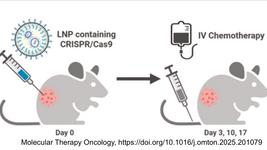Carbon
CARBON Newsletter (27 July) - Your Latest News About CRISPR in AgroBio
By: Gorm Palmgren - Jul. 27, 2022
CRISPR AgroBio News (CARBON) is a new initiative from CRISPR Medicine News. CARBON will bring you the latest news on how CRISPR can shape agriculture for the future to guarantee food security in times of population growth and climate change.
To get more CRISPR AgroBio News delivered to your inbox, sign up to the free weekly CARBON Newsletter here.
Top picks
- Researchers in Spain have developed two simple and effective CRISPR-based methods for detecting infection with three common RNA viruses in Nicotiana benthamiana plants. In one setting, Cas13a was used in crude leaf extracts without prior amplification together with crRNA targeting either Tobacco mosaic virus, Tobacco etch virus or Potato virus X. Upon detection of the viral RNA, collateral cleavage of an ssRNA probe labelled with a fluorophore and a quencher led to fluorescence readout. In another setting, Cas12a was used similarly after PCR or isothermal amplification, and this method could also be used for multiplexed detection in plants with mixed infections.
- Agroinfection with a potato virus X (PVX)-derived vector has been used to deliver part of the CRISPR toolkit to Nicotiana benthamiana. The Spanish researchers behind the achievement used the vector to deliver gRNAs to plants already transformed with the remaining complementary CRISPRa components that mediate strong programmable transcriptional activation in plants. After spraying N. benthamiana leaves with the virus vector, the gRNAs mediated a strong activation response in different target genes that moved locally and systemically.
Technical advances
- Chinese researchers have developed a highly efficient prime editor (PE) 2 system in plants by stacking various optimization strategies. These include updating the PE architecture to PEmax and expressing engineered pegRNA with a structured motif under the control of a composite promoter. The system enabled editing frequencies of 65% to 77% in rice.
- A new and efficient base editing system has been established in rice. It was made by fusing the highly active cytidine deaminase evoFENRY and the PAM-relaxed Cas9-nickase variant Cas9n-NG with rice and human uracil DNA N-glycosylase (rUNG and hUNG). The system achieved C-to-G conversions with monoallelic editing efficiencies of up to 27% in T0 rice. However, a similar approach to generate A-to-Y (C or T) base editors was unsuccessful and led to no detectable A-to-Y editing.
Disease control
- CRISPR gene editing has been used to obtain melon (Cucumis melo) resistant to Moroccan watermelon mosaic virus (MWMV). Researchers in Spain used the technology to knock out the eIF4E gene by generating a single-nucleotide deletion in the first exon. The gene has previously been associated with virus resistance, and now the researchers found that its knockout also resulted in male sterility.
Detection
- Chinese researchers have developed a CRISPR-based field test for sex determination of earlier porcine embryos and pork products. The method uses Cas12a coupled with either PCR or LAMP targeting the sex-determining region Y (SRY) and the zinc finger protein X-linked (ZFX) genes. Amplicons were cleaved with the subsequent generation of fluorescing products that could be detected with portable blue and ultraviolet light transilluminators.
Climate change
- A feature in National Geographic dives into the recent efforts of plant and soil scientists to use CRISPR genome editing to vastly increase and speed up carbon storage and thereby help fight climate change. As pioneers in the field, Innovative Genomics Institute (IGI) scientists are trying to generate plants and microbes that can accumulate CO2 and turn the greenhouse gas into polysaccharides like cork (suberin) that form a stable soil carbon pool that can last decades or longer. Other initiatives aim at generating plants with more and longer roots that can store carbon deep below ground.
- A report from the European Parliament addresses genome-edited crops and their potential for solving the global food crises imposed by climate change and other challenges. The concise 28 pages report focuses on risks, regulation, detectability and legislative challenges for bringing CRISPR gene-edited crops to the market.
Industry
- American startup SCiFi Foods has secured $22 million of Series A funding to support using CRISPR to develop a sustainable burger product. The burger will be made using plant-based proteins and cultivated meat, which is real animal meat made by growing gene-edited animal cells in single-cell suspension in a bioreactor.
Reviews
- A review by Indian researchers summarizes the progress of using the CRISPR toolkit in plant pathology. The paper details the successful genome editing applications for host plant resistance against a wide range of biotic factors and the use of CRISPR-Cas gene drive to suppress the population of pathogens and pests. Moreover, the use of CRISPR-Cas as a diagnostic tool is discussed.
- Researchers from Ghana and China discuss the feasibility of employing CRISPR/Cas-mediated genome editing techniques for the genetic enhancement of minor legumes and de novo domestication of their wild relatives. De novo domestication is the process of editing resilient wild relatives of crops to improve their food, nutritional or raw material utilization value.
Tags
CLINICAL TRIALS
IND Enabling
Phase I
Phase II
Phase III
Gastric Cancer and Colorectal Cancer, CRC, (NCT07166263)
Sponsors:
Base Therapeutics (Shanghai) Co., Ltd.
Sponsors:
Base Therapeutics (Shanghai) Co., Ltd.
IND Enabling
Phase I
Phase II
Phase III
Relapsed or Refractory Acute Myeloid Leukemia, AML, (NCT06541444)
Sponsors:
Base Therapeutics (Shanghai) Co., Ltd.
Sponsors:
Base Therapeutics (Shanghai) Co., Ltd.
IND Enabling
Phase I
Phase II
Phase III







